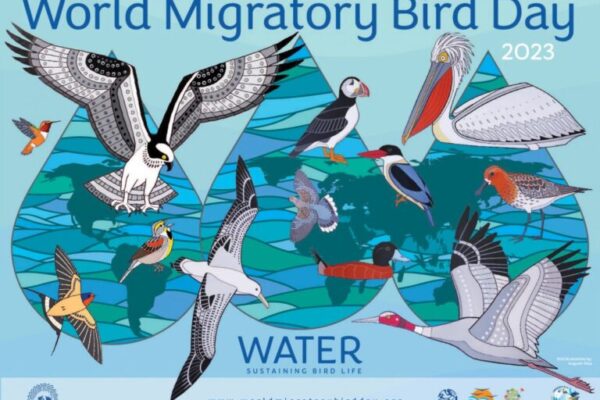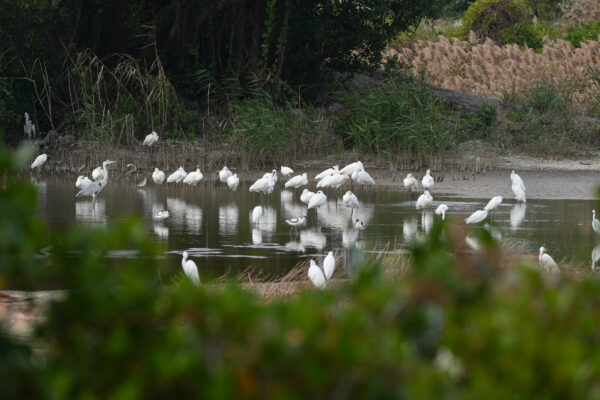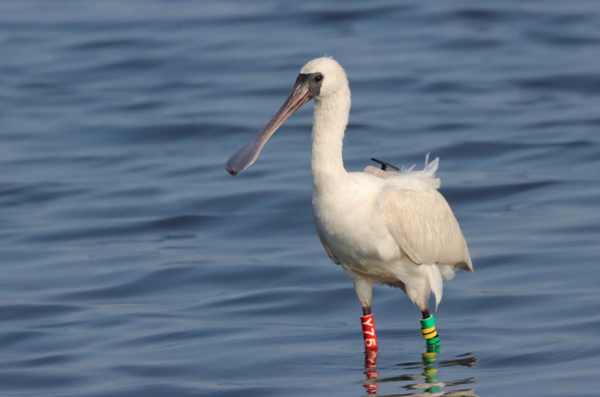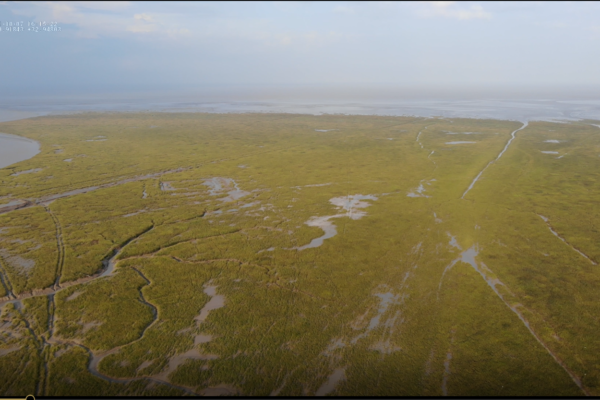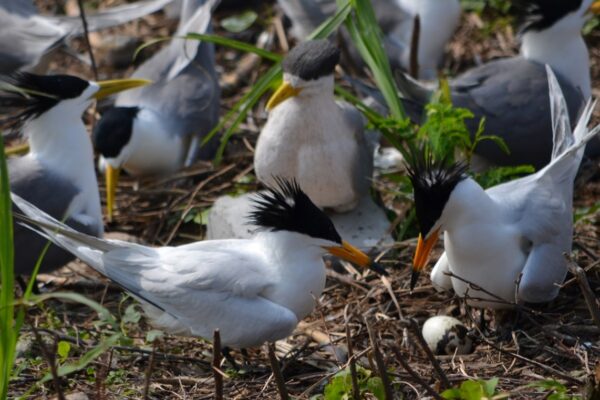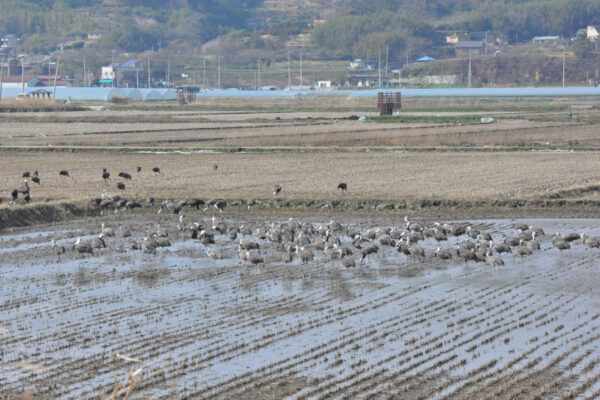-
2023 Incheon International Education Forum : Policies and Practices on Climate Change Education in North-East Asia
©UNESCAP As Climate Change is an emerging global issue in the past decade, its impacts cannot be addressed without the participation of all generations. In particular, young people will be mostly taking the risk and consequences of Climate Change for the longest duration. Therefore, it is crucial to provide high-quality climate change education by strengthening the capacity of educators and empowering youth in the efforts to tackle climate change. In light of this, the Incheon Metropolitan City Office of Education and the UN ESCAP Subregional Office for East and North-East Asia jointly organized the "2023 Incheon International Education Forum" on May 30-31, 2023, in Incheon, Republic of Korea. The forum centered around the theme of "Policies and Practices on Climate Change Education in North-East Asia." The forum aimed to promote the exchange of knowledge and experiences, focusing on climate change education (CCE) in the East and Northeast Asia region. It aimed to discuss how stakeholders can collaborate to provide effective climate education to the youth. Over 50 participants from the education sector, including school teachers and students, as well as international and local organizations, joined the forum, which consisted of six sessions. The forum began with an opening ceremony featuring remarks by Ms. Miyoung Lee, President of the Incheon East Asia Global Education Institute, Mr. Ganbold Baasanjav, Head of the East and North-East Asia Office, UNESCAP, and Mr. Chungsik Sin, Chairperson of the Education Committee, Incheon Metropolitan Council. Two keynote speeches were delivered by Mr. Seonghoon Do, Superintendent of the Incheon Metropolitan City Office of Education, and Mr. Henry Gonzalez, Executive Director a.i. of the Green Climate Fund. The first session, titled "Policies on Climate Change Education," focused on researchers from China, Japan, Mongolia, and South Korea sharing the current status of Climate Change Education in their respective countries. In the second session, titled "Student-friendly Climate Curriculum and Programs," presenters from China, Mongolia, and South Korea emphasized the importance of developing curricula on climate change-related subjects. They discussed the situation of CCE programs in schools from the perspectives of NGOs and researchers, evaluating and sharing gaps in CCE. The last session of Day 1 was dedicated to "Capacity Building for Educators." Presenters from WWF-China, UNESCO (ACCU), and the Incheon Metropolitan City Office of Education shared their programs aimed at equipping and training educators on CCE. They also discussed strategies for building collaboration and networks for CCE or environmental education in the region. On Day 2, the fourth session, titled "Climate Education Activities at a City and/or Community Level," commenced with a series of five presentations highlighting educational activities for young people both inside and outside of school. The speakers represented diverse backgrounds, ranging from NGOs like the Climate Change Center and Youth Origin Education in China to local schools in Japan and South Korea. Ms. Vivian Fu, Senior Communication Officer of the EAAFP Secretariat, also shared insights on linking Climate Change Education (CCE) to wetlands and advocated for leveraging existing educational facilities at these sites to enhance CCE. Vivian Fu, Senior Communication Officer of the EAAFP Secretariat, presenting about the links of conservation of wetland and migratory waterbirds with Climate Change Education (CCE) ©UNESCAP Session 5 focused on Global Developments in Climate Change Education, featuring panelists such as Ms. Won Jung Byun from UNESCO Headquarters, Mr. George Zedginidze, Head of Knowledge Management at the Green Climate Fund, Mr. Mozaharul Alam, Regional Coordinator for Climate Action at UNEP Asia and the Pacific Office, and Ms. Elly Herliani from the Southeast Asian Ministers of Education Organization. They discussed ways and mechanisms through which their organizations could incorporate CCE activities and synergize strategies and resources. Following that, a special session titled "Voices of the Youth" was held, during which five students from middle and high schools in Incheon presented their activities, including studying birds and plants at wetlands and conducting awareness-raising activities at schools and local communities. All participants were deeply impressed by the work and enthusiasm demonstrated by these students. The students also actively participated in the final session, an interactive discussion on future (sub-)regional cooperation in climate change education, alongside all the participants. The presenter from NGO Youth Origin Education (left) and student presenters (right) ©UNESCAP For more information on the event and presentations, please visit: https://unescap.org/events/2023/2023-incheon-international-education-forum-policies-and-practices-climate-change
Continue reading -
World Migratory Bird Day 2023 highlights impact of the growing water crisis on migratory birds
BOULDER/BONN/INCHEON, 13 May 2023 – Water and its importance to migratory birds – and the increasing threats to both water quality and quantity - is the focus of this year’s World Migratory Bird Day, a global campaign that aims to raise awareness of migratory birds and the need for international cooperation to conserve them. Activities to mark the campaign will be held globally on two peak days in May and October under the theme “Water: Sustaining Bird Life” Water is fundamental to sustaining life on our planet. Migratory birds rely on water and its associated habitats—lakes, rivers, streams, ponds, swamps, marshes, and coastal wetlands—for breeding, resting, refueling during migration, and wintering. Yet increasing human demand for water, along with climate change, pollution, and other factors, are threatening these precious aquatic ecosystems. Headlines around the world are sounding alarm: 35 percent of the world’s wetlands, critical to migratory birds, have been lost in the last 50 years. Utah’s Great Salt Lake, the largest saltwater lake in the Western Hemisphere and used by more than a million shorebirds, is in danger of disappearing within five years. Across the Amur-Heilong Basin in Asia, climate change is amplifying the impact of habitat destruction by depleting natural water systems and depriving migratory birds of vital breeding and stopover site. These sobering examples go hand-in-hand with recent reports that reveal that 48 percent of bird species worldwide are undergoing population declines. Another poignant example is that of the Aral Sea shared by Kazakhstan and Uzbekistan. Once the fourth-largest lake in the world, it is widely regarded as one of the planet’s worst water-related environmental disasters. Soviet-era irrigation projects almost completely dried up the lake, which led to the loss of livelihoods for fishermen and farmers and the deterioration of public health due to toxic dust and reduced access to clean water. The impact has been severe for the communities around the lake, but also for migratory birds, which lost important food sources and a critically important stopover point on their journey. Another example is the Sahel, a vast semi-arid region in Africa: Prolonged periods of drought, deforestation, and overgrazing in the Sahel have led to the degradation of the soil and loss of vegetation, threatening the survival of both the local human population and wildlife, including migratory birds. Lake Chad, one of the largest water bodies in Africa in 1960, lost 90 % of its area, depleting water resources for local communities and also for many migratory birds. World Migratory Bird Day serves as an international call to action for the protection of migratory birds, whose ranges often span multiple countries, and are facing many different threats worldwide. The annual campaign is organized by the Convention on the Conservation of Migratory Species of Wild Animals (CMS), the African-Eurasian Migratory Waterbird Agreement (AEWA), Environment for the Americas (EFTA), and the East Asian-Australasian Flyway Partnership (EAAFP). World Migratory Bird Day 2023 will be officially held on 13 May and 14 October. The two days of World Migratory Bird Day reflect the cyclical nature of bird migration as well as the fact that there are varying peak migration periods in the northern and southern hemispheres. Events to raise awareness of migratory birds and the importance of water will take place all over the world including in local parks, nature centers, museums, libraries, schools, and other locations on these peak days and throughout the year. To learn more about this year’s World Migratory Bird Day campaign and actions to take, visit www.worldmigratorybirdday.org and EAAFP WMBD 2023 webpage: https://www.eaaflyway.net/world-migratory-bird-day-2023/ Also, please have a look of the Campaign Strategy for promoting World Migratory Bird Day, click [here]. For more resources, visit the Trello Board [here]. Message from the Partners of World Migratory Bird Day Convention on Migratory Species (CMS) “Water is essential for people as well as for migratory birds and other wild species of animals. Yet around the world, the availability and quality of water is under enormous pressure, with deeply concerning implications. The looming global water crisis requires urgent action by governments, businesses, local communities as well as individuals. Because migratory birds cross national borders and even continents, international cooperation is essential to ensure that actions are taken to conserve and restore important habitat for migratory birds, and to address the drivers of water loss, pollution, and climate change,” said Amy Fraenkel, Executive Secretary of the Convention on the Conservation of Migratory Species of Wild Animals (CMS). African-Eurasian Migratory Waterbird Agreement (AEWA) “The water crisis recently highlighted by the UN 2023 Water Conference also has a tremendous impact on migratory birds. In the Sahel in particular, many wetlands on which migratory waterbirds rely during the non-breeding period are shrinking. Water is a vital resource for all, local communities as well as birds. By reducing our consumption, combatting climate change, and managing wetlands wiser, we can improve the situation,” said Dr. Jacques Trouvilliez, Executive Secretary of the Agreement on the Conservation of African-Eurasian Migratory Waterbirds (AEWA). Environment for the Americas (EFTA) “World Migratory Bird Day 2023 spotlights the vital role that water plays in the survival of our shared birds. The focal species illustrated on the campaign poster depict the intricate bond each bird shares with water. The diminutive Rufous Hummingbird thrives on nectar-producing flowers that rely on water for their blooms, and the Dickcissel scours the grasslands for seeds that hold the moisture they need. White Pelicans and Ospreys seek their prey in freshwater lakes, while the magnificent Wandering Albatross and Atlantic Puffin remain at sea. WMBD is an opportunity to unify our voices for the conservation of migratory birds and to celebrate their spectacular journeys,” said Dr. Susan Bonfield, Executive Director at Environment for the Americas (EFTA). East Asian-Australasian Flyway Partnership (EAAFP) “This year's WMBD theme serves as a vital reminder of the linkage of migratory birds to the importance of protecting aquatic ecosystems and conserving wetlands. As birds such as threatened Spoon-billed Sandpiper, Dalmatian Pelican, and Sarus Crane migrate, they rely heavily on wetlands for survival. We must take urgent actions and collaborate at all levels, from citizens to among governments, to tackle the problems of saving water and aquatic ecosystem, and ensure that migratory birds continue to thrive.” Ms. Yeounhee Ahn, Deputy Executive of East Asian-Australasian Flyway Partnership (EAAFP).
Continue reading -
Revealing migration of an unknown EAAF waterbird: The Wood Snipe
EAAFP Small Grant Fund Project by Xiaotong Ren, Peking University Shen Zhang, Shanshui Conservation Center On the remote alpine meadows of Pingwu County, Mianyang, Sichuan, China, there is a mysterious bird species that even locals rarely have a chance to see. Some of the villagers who often go to the alpine meadow said: “The call and flight of 'mud driller' (the name for Wood Snipe by local people, because it usually feeds on the ground) could be heard nearby when we stayed in huts at night. Sometimes, the sound of its flight is very strange, like there are little bells on its body, and it ‘po-po-po’ falls to the ground.” This is the Wood Snipe (Gallinago nemoricola, Figure 1). Snipes (Gallinago spp.) are a very special group of shorebirds: unlike most "typical" shorebirds that prefer to live on muddy or sandy riverbanks and beaches, snipes tend to live in concealed wetland vegetation. The Wood Snipe is an even more distinctive species among snipes. According to historical specimen collections and birdwatching records, they appear in tropical forests near South Asia and Southeast Asia in winter but breeds in alpine meadows of the Himalayas and Hengduan Mountains in summer. Figure 1. Wood Snipe at Pingwu County ©Tong Mu The mystery of Wood Snipes is largely due to the difficulty in reaching alpine meadows, combined with their secretive behavior. Basic information about the species, such as population size, complete distribution range, habitat preferences, diet, and behavior, is extremely scarce. Prior to our project, the only modern research conducted on this species was a population survey project in Nepal. Current knowledge of the species is mostly based on piecing together various historical records and sporadic birdwatching records. While we know almost nothing about basic aspects of Wood Snipes, they have already been listed as Vulnerable in the IUCN Red List, with a declining population estimated at only 2,500-9,999 individuals globally. As the Chinese proverb goes, "the beginning is always the hardest," our fieldwork started in the midst of great unknowns. Based on historical records, interviews with local residents, and valuable information from Mr. Wang of the Mianyang Birdwatching Society, we speculated that the Wood Snipes would appear in early May at their breeding ground in Pingwu County. Our advance team gathered to conduct a final recce in late April 2021 before the formal field work started. However, to everyone's surprise, the Wood Snipes had arrived before us, even though it was still snowing heavily on the mountain (Figure 2). Just as the locals had said, we didn't spot any of them until nightfall when we heard their flying and singing near our shelters. The first batch of team members quickly assembled and departed on April 30th, only several days after the recce, rushing into the formal field work stage. Figure 2: Heavy snow suddenly falls when we were searching for Wood Snipes. The snowy weather at our study area could last until the beginning of June From May 1st, we started our 2-month fieldwork on alpine meadow living at a simple and crude camp (3400m in elevation, Figure 3) without electricity and stable mobile phone signal but surrounded by Wood Snipe display every sunrise and sunset. Our objective was to investigate the population size and distribution of Wood Snipes and characterize the habitats and threats to Wood Snipes at our study area and to identify the migratory route and wintering grounds of the Wood Snipe population that breeds in the Hengduan Mountains. We conducted population size and distribution survey, preliminary observation and description of breeding biology, call survey, individual capture and banding, survey for habitat characteristics and food resource. Figure 3: Camp site in the field We recorded a total of 123 Wood Snipe occurrence sites during the field survey in 2021. We estimated there were 9 home ranges in the entire study area, each representing 1 - 2 adult individuals. We also found that across the entire alpine meadow which seemed identical to us ranging from about 3400 - 3750 m, Wood Snipes preferred lower elevation (<3600m) and median level of soil moisture. They also had a higher probability of occurrence at sites with more potential food resources (soil macroinvertebrates). We also captured and banded 7 individual Wood Snipes and successfully fitted tracking devices to them while ensuring that the weight of each tracking device was less than 5% of the corresponding individual's body weight (Figure 4). Since the tracking devices were unstable, we only had the southward migration routes for two individuals and northward migration route for one individual (Figure 5). This was the first time that the migration of this cryptic species had been revealed. Figure 4: Wood Snipe individual fitted with satellite transmitter Figure 5: Map of Wood Snipe tracking in non-breeding season. Individuals marked by colors: orange indicates south-ward migration of one individual, dark blue and light blue indicate south-ward and north-ward migration of another individual respectively Our work for Wood Snipe in 2021 is just the beginning for the study and conservation of this species and much remains to be done in the future. You could find more details in our report and future publications. Please contact us if you are interested in our project or have any questions about it. The project was funded through the 2021 EAAFP WG/TF Small Grant Fund. View the report, Click here.
Continue reading -
Global population of Black-faced Spoonbill continues to break new record
© Jay Kong/HKBWS Coordinated by EAAFP Partner, The Hong Kong Bird Watching Society (HKBWS), the International Black-faced Spoonbill Census 2023 was conducted from 6th to 8th January 2023. Global population of Black-faced Spoonbills (BFSs) reaches another record high of 6,603, a rise of 7.2% (i.e. 441 individuals) from last year. However, 299 individuals were recorded in the Deep Bay area across Hong Kong and Shenzhen, which is 70 individuals less compared to last year. The number shows a decline of 11% and 19% from 2021 and 2022 respectively. Steady growth in Taiwan, Mainland China and Korea while moderate decline in Japan and almost 20% drop in Deep Bay The census covered about 130 sites all over the world. Taiwan, Mainland China and the Republic of Korea are the major regions which attribute to the growth in the overall population. Taiwan remains the largest congregation site with 4,228 individuals comprising 64% of the global population. The year-on-year growth is 10.6%. In Mainland China, 1,307 individuals and 15.1% year-on-year growth were recorded. The number comprised 20% of the global population. In Ro Korea, the number of BFS reaches 54 individuals with an increase of 45.9%, i.e. 17 individuals. Contrarily, in Japan 610 individuals are recorded which shows a decline of 10.7% from last year, i.e. 73 individuals less. The results this year shows that the global population of Black-faced Spoonbills has increased steadily. The numbers in Taiwan and Mainland China have been setting new records in recent years, which suggests the conditions in those habitats are favourable for a larger number of Black-faced Spoonbills to stay or to gather. Favourable conditions may refer to a safe environment, and sufficient food sources in nearby feeding grounds. The decline in Japan might be related to the loss of stopover sites and the outbreak of bird flu, according to local experts. In Deep Bay area, 299 individuals were recorded, which is the second lowest record in the last decade. Compared to last year, there were 70 individuals les, that is 19% decline. Having reached its record high of 462 individual in 2010, the number of BFS in Deep Bay has not advanced since then and remained above 300 from 2016 until it dropped to 299 this year. The result this year is worrying. Fig. 1 Black-faced Spoonbill Census results 1989-2023 © HKBWS Fig. 2 Black-faced Spoonbill Population size and distribution © HKBWS Fig. 3 Black-faced Spoonbill Census results regional breakdown 1989-2023 © HKBWS The problem of habitat degradation must be confronted, and conservation should be prioritized in the Northern Metropolis Development Strategy The decline in the number of Black-faced spoonbills in Deep Bay area is alarming to Hong Kong. Black-faced Spoonbills mainly forage in the intertidal mudflats of Deep Bay, shallow waters in Gei Wai, and drained fishponds. As the Ramsar Wetland in Mai Po Inner Deep Bay is relatively adequately protected by law, these habitats can be maintained in relatively good conditions. However, the habitats outside the nature reserve are facing different threats. Without immediate measures, they may become unsuitable for Black-faced Spoonbills to loaf and feed. For instance, the expansion of mangroves, including the invasive species Sonneratia caseolaris, continues to eat up the mudflats resulting in a reduction in the habitat available to Black-faced Spoonbills. On the other hand, nearly 30% of the fishpond wetlands and the buffer zones in Deep Bay are hoarded by real estate developers or held privately. These lands have been abandoned or the land use has been altered, which continuously causes habitat degradation in the Deep Bay area. If proactive conservation and management actions are not taken immediately, there is a risk for losing these important winter habitats of the Black-faced Spoonbills’. In order to protect the Black-faced Spoonbill, many countries and cities put great effort into different conservation actions in the past 30 years, and finally the decline of the species is successfully reversed. "It is especially important to establish comprehensive protection laws, long-term conservation strategies and good land use planning, which can restore endangered species and even biodiversity around the world." Mr. Yu Yat-tung, Director of The Hong Kong Bird Watching Society, continued, "The future of the Deep Bay wetlands is determined by the conservation and planning of the Northern Metropolis Development Strategy. To protect the ecological integrity of this internationally important wetland, the Northern Metropolis must comply with the guidelines to protect "Wetland Conservation Area" and "Wetland Buffer Area". The wetland conservation park system must fully cover the "Inner Deep Bay and Shenzhen River catchment area" Important Bird Area recognized by BirdLife International, and ensure them to be protected by stricter laws and regulations; also a management model that is people and ecology oriented must be applied.” Hong Kong is responsible for the proper protection of wetlands and biodiversity, the maintenance of the important ecological corridors for migratory birds, and the assistance to China in fulfilling its obligations under the “Convention on Biological Diversity” and the “Convention on Wetlands”. The Hong Kong Bird Watching Society hopes that the Northern Metropolis can practice "ecological priority", through proper management and conservation of the Deep Bay wetlands, turn crisis into opportunity, and maximize the benefits of bird conservation. Fig. 4 Trend of Black-faced Spoonbill population in Deep Bay © HKBWS About The International Black-faced Spoonbill Census Black-faced Spoonbill is listed as "Endangered" on the International Union for Conservation of Nature's (IUCN) Red List of Threatened Species. The International Black-faced Spoonbill Census takes place every January ever since it was first launched in 1994. During Census 2023, more than 200 veteran birdwatchers, conservationists, researchers and ornithologists were mobilized to record the number of wintering Black-faced Spoonbills at about 130 sites. Reposting of news article from Hong Kong Bird Watching Society with permission, original article (link). Learn about EAAFP Black-faced Spoonbill Working Group: https://www.eaaflyway.net/black-faced-spoonbill-working-group/
Continue reading -
Juvenile distribution pattern and conservation of the endangered Black-faced Spoonbill
EAAFP Small Grant Fund Project by Chi Yeung Choi, Jimmy Duke Kunshan University The individually-marked Black-faced Spoonbill ‘Y75’, was one of the twenty individuals tagged with satellite tracker. Y75 was ringed on Chilsando, Korea, 2nd July 2020, then seen on Taiwan Island 26th October 2020 ©Yi-Cheng Chen Among the threatened migratory waterbird species in the East Asian–Australasian Flyway (EAAF), the Black-faced Spoonbills (BFS) Platalea minor stands out as one of the very few species showing a recovering trend, from just a few hundred to more than 6,000 over the last 30 years partly due to the extensive conservation effort and BFSs’ ability to utilise artificial wetlands. Over the years, the foraging ecology (Yu et al. 2004a), habitat use (Yu et al. 2004b), threats (Sung et al. 2018) and migration routes (Wood et al. 2013) of BFS have been studied in various locations. Yet relatively little is known about their movement ecology, especially juveniles. In this proposed project, we aim to quantify the wintering distribution pattern of juvenile BFS in their first boreal winter using GPS-GSM transmitters. The ultimate goal is to identify the key regions where juvenile BFS winter and safeguard these areas for the continuous recovery of this endangered population. In 2020 June and July, juvenile BFS were captured near their nests from breeding islands along the west coast of South Korea. Measurements were recorded and unique colour ring combination on the tibia of BFS was used for individual marking. Solar-powered GPS/GSM satellite trackers (19g or 1.3% of juvenile BFS body weight) were deployed to the back of spoonbills using backpack method. Twenty juvenile BFS were captured and equipped with satellite trackers on their back during June and July 2020. Five individuals died without leaving Korea while one individual with tracker failure. In the remaining 14 individuals that left Korea and migrated, 10 of them (71.4%) spent their first winter in mainland China, two (14.3%) on Taiwan Island and two (14.3%) in southeast Japan. Among the 10 individuals that spent their first winter in mainland China, three individuals (30%) stayed in Jiangsu province and another three individuals (30%) in Zhejiang province, while two individuals (20%) resided in Guangdong, one individual in Hainan and one in Anhui. About half of these 14 wintering sites were protected. Among the 14 individuals that left Korea, the one that spent its first winter at the highest latitude (Jiangsu Lianyungang) and the one at the lowest latitude (Hainan) eventually died during their first winter. Our results showed the importance of the coastal wetlands in mainland China, especially those along the Jiangsu, Shanghai and Zhejiang coasts, for juvenile BFS during their southward migration and first winter. All tracked individuals that flew across the Yellow Sea from the west coast of Korea made their first landfall in coastal wetlands along the Jiangsu, Shanghai and Zhejiang coasts. The tracking results indicated the importance of coastal wetlands in Zhejiang Zhoushan, Hangzhou Bay and Wenzhou Bay to juvenile BFS. Moreover, two of the tracked birds that migrated successfully to mainland China for their first winter, eventually died at Lianyungang and Hainan. The cause of mortality was unclear but 35% of tracked BFS died within 6 months after released, showing the challenges that young BFS faced in their early years. It is important to record the potential cause of mortality and mitigate those threats to ensure the continuous population recovery of this endangered species. This project laid the important foundation for further tracking projects that will help researchers to determine the potential drivers for the observed juvenile wintering distribution pattern. This could be achieved by combining the tracking data with findings with annual synchronized censuses. Moreover, the tracking data could also be used to evaluate the extent to which protected areas along the flyway encompass the full range of habitats used by BFS during non-breeding season. The southward migration pathway and wintering distribution of satellite-tracked Black-faced Spoonbills in 2020 References: Sung Y-H, Tse IW-L, & Yu Y-T. 2018. Population trends of the Black-faced Spoonbill Platalea minor: analysis of data from international synchronised censuses. Bird Conservation International, 28(1), 157-167. Wood, C., Tomida, H., Jin-Han, K., Lee, K.S., Cho, H.J., Nishida, S., Ibrahim, J., Hur, W.H., Kim, Yu YT, & Swennen C. 2004a. Feeding of wintering Black-faced Spoonbills in Hong Kong: When and how long? Waterbirds, 27(2), 135-140. Yu YT, & Swennen C. 2004b. Habitat use of the Black-faced Spoonbill. Waterbirds, 27(2), 129-134. The project was funded through the 2020 EAAFP WG/TF Small Grant Fund. View the report, Click here.
Continue reading -
An Overview of China’s Policy on Spartina Control
Spartina in the estuary © Paulson Institute Mid-February 2023, five Chinese government departments, including the National Forestry and Grassland Administration, together with relevant departments of the State Council, issued the Special Action Plan for the Prevention and Control of Spartina (2022-2025), which sets the goal of effectively controlling Spartina alterniflora throughout China by 2025, with a removal rate of over 90% in all provinces. The Action Plan is undoubtedly a shot in the arm for the coastal provinces to triumph over this invasive Spartina cordgrass and safeguard coastal ecosystems. Spartina cordgrass is native to the east coast of North America and the Gulf of Mexico, and was introduced to China for scientific research and utilization in 1979. Due to its salt tolerance and flood resistance, strong fecundity and well-developed root system, it was considered to be the best plant for promoting sedimentation, protecting embankments, and facilitating siltation and land formation. In the following 20 years, Spartina was widely introduced in many estuaries and mudflats of coastal China. However, there have been unforeseen negative consequences. With artificial planting and natural spread, Spartina now grows on coastal mudflats from Liaoning in the north to Hainan in the south, severely altering the natural environment and ecosystem processes of China's coastal wetlands. This, in turn, has negatively impacted biodiversity and ecosystem service values, and caused significant losses to aquaculture and shipping industries, among others. The history of Spartina control in China can be traced back to the late 1990s, when some scholars pointed out the danger of "widespread and uncurbed growth of Spartina" and recommended thorough research and development of site-specific eradication plans before implementing control projects. Later, as biological invasion became a new research topic of high interest to Chinese ecologists, the harmfulness of Spartina was further revealed, drawing the attention of the Chinese government. In order to tighten the prevention and control of Spartina, the Ministry of Ecology and Environment (formerly SEPA) included Spartina in the List of Invasive Alien Species (First Batch) in 2003, and the Ministry of Agriculture and Rural Affairs (formerly Ministry of Agriculture) included Spartina in the List of Invasive Alien Species for Key Nationwide Efforts of Control (First Batch) in 2013. Although Spartina was classed as an invasive species by China, some scholars suggested recognizing its positive ecological effects, such as wind and wave resistance, siltation and land formation, and carbon sequestration thus balancing the negative ecological effects. Since there was no strict legal basis to regulate exotic plants management at the time, and the two-sided nature of Spartina's ecological benefits had diminished the determination at the local level to eradicate this weed, control measures were not adopted fast enough to curb its rapid spread. Even in the late 2000s, Spartina was still being artificially planted in the mudflats of intertidal zones in some areas. Fortunately, while Spartina was spreading rampantly along China's coastline, the legal and policy system for invasive species was constantly being revised and improved. The 13th Five-Year Plan for National Ecological Protection called for "actively preventing and controlling invasive alien species" and "exploring and driving the system for managing biosafety and invasive alien species". This process has accelerated in recent years. The Biosafety Law of the People's Republic of China, which was implemented in 2021, proposes to "develop a list of invasive alien species and management methods" and "enhance the investigation, monitoring, early warning, control, assessment, removal and ecological restoration of invasive alien species". It also clearly stipulates that "no organization or individual may release or discard alien species without approval." The Wetland Protection Law of the People's Republic of China, which came into force in June 2022, also provides that "it is prohibited to introduce and release alien species into wetlands, and there should be science-based evaluation and approval in accordance with the law for those that do need to be introduced". To effectively strengthen the management of invasive alien species, the Ministry of Agriculture and Rural Affairs, the Ministry of Natural Resources, the Ministry of Ecology and Environment, and the General Administration of Customs promulgated the Measures for the Management of Invasive Alien Species in August 2022, which stipulates risk assessment, monitoring and early warning, and comprehensive control of invasive alien species. This document also proposes that invasive alien plants can be controlled with manual uprooting, mechanical eradication, spraying of green chemicals, release of natural enemies and other methods during the critical growth periods such as seedling, flowering or fruiting. At the same time, in response to the serious challenges facing coastline protection and utilization, China has introduced a series of targeted policies and invested resources to support the protection of coastal zones and the restoration of coastal wetland ecosystems, including the restoration of intertidal mudflats encroached by Spartina. For example, in 2020, the Master Plan on the Major Projects for the Protection and Restoration of China’s Key Ecosystems (2021-2035) proposed to "pursue comprehensive coastline and mudflats restoration, habitat conservation and restoration, and prevention and control of invasive alien species and ecological disasters", and "improve ecosystem quality of near-shore sea areas, restore typical habitats that have degraded and step up the protection of habitats along bird migration routes". The Plan also places particular emphasis on reinforcing the prevention and control of overgrown invasive alien species such as Spartina. In August 2020, the Ministry of Natural Resources and the National Forestry and Grassland Administration jointly issued the Special Action Plan for Mangrove Protection and Restoration (2020-2025), which focuses on " intensifying the efforts to prevent and control harmful overgrowth of species such as Spartina". The just-released Special Action Plan for the Control of Spartina (2022-2025) was proposed in the context of the general trend that the Spartina invasion has caused a continuous decline in coastal wetland biodiversity, as well as recognizing that its invasion has not been effectively curbed and control measures are therefore much needed. In addition to a whole-territory background survey and comprehensive control, monitoring and assessment, the Action Plan will promote the ecological restoration of treated mudflats, bolster later-stage management and protection, and "adapt the measures to local conditions" by referring to the original ecosystems. At the same time, it will strengthen the scientific and technological support for Spartina prevention and control, formulate the Technical Guideline for Comprehensive Prevention and Control of Spartina to guide the precise treatment in different places, and further improve the laws and regulations and institutional system for work in this area. It is estimated that the current area of Spartina in China is about 68,000 hectares, more than twice the area of existing mangroves and equivalent to half the size of Chongming Island. If these mudflats can be restored to their original ecological functions after the removal of Spartina, they will provide new high-quality habitats for many migratory waterbirds along the East Asian-Australasian Flyway, protecting this shared natural heritage for future generations. Spartina control pilot in Yancheng (left) and Luannan (right) © Paulson Institute (Chinese version) 中国治理互花米草的政策概述 近日,中国国家林业和草原局等五部门会同国务院有关部门印发了《互花米草防治专项行动计划(2022—2025年)》,提出了力争到2025年全中国互花米草得到有效治理,各省份清除率达到90%以上的目标。这一行动计划无疑是为沿海各省打赢互花米草围剿战,实现全面构建坚实的海岸带生态安全屏障的目标注入了一剂强心针。 互花米草原产于北美东海岸及墨西哥湾,1979年被引入中国进行科学研究和开发利用。由于互花米草具有耐碱耐淹、繁殖力强、根系发达等特点,当时它被认为是保滩护堤、促淤造陆的最佳植物。在之后的20多年里,互花米草在中国广大的河口与沿海滩涂被广泛引种,用于促淤造陆和保滩护岸等工程,取得了一定的生态和经济效益, 但也带来了一系列危害:经过人工种植和自然繁殖扩散,互花米草在我国北起辽宁南至海南沿海海滩上均有生长,严重改变了中国滨海湿地的自然环境和生态系统过程,降低了生物多样性和生态系统服务价值,并使水产养殖业和航运业等遭受重大损失,造成了严重的生态和经济后果。 中国治理互花米草的历史可以追溯到上世纪90年代末,当时就已经有学者提出“米草蔓延成灾”的危害,并建议在实施治理工程前做周密的研究,制定因地制宜的根治方案等。之后随着生物入侵成为中国生态学界新的研究热点,互花米草的危害性也被进一步地揭示,并受到了中国政府的重视。为了加强互花米草的防控和治理,生态环境部(原国家环保总局)于2003年将互花米草列入《外来入侵物种名单(第一批)》,农业农村部(原农业部)于2013年将互花米草列入《国家重点管理外来入侵物种名录(第一批)》。虽然互花米草被国家盖了“入侵种”的帽子,但是考虑到其抗风防浪、促淤造陆和固碳等正生态效应,也有学者建议应充分发挥其正生态效应,抑制负生态效应,对其实行生态控制,同时对互花米草的生物质进行开发利用。由于彼时并没有严格的法律依据来规范外来植物的管理,而其生态效益的两面性又动摇了地方根除互花米草的决心,导致互花米草的治理进程远不敌其扩散速度,甚至在00年代末,仍有一些地区在潮间带光滩人工栽种互花米草。 幸亏当互花米草在中国沿海肆虐扩散的同时,针对入侵生物的法律和政策体系也在不断地修订完善。《全国生态保护“十三五”规划》就已经开始要求“积极防治外来物种入侵”, “探索推进生物安全和外来入侵物种管理制度化进程”。而这一进程在近几年开始加速。 2021年实施的《中华人民共和国生物安全法》提出要“制定外来入侵物种名录和管理办法”,“加强对外来入侵物种的调查、监测、预警、控制、评估、清除以及生态修复等工作”,并明确规定“任何单位和个人未经批准,不得擅自释放或丢弃外来物种”。2022年6月实施的《中华人民共和国湿地保护法》也规定“禁止向湿地引进和放生外来物种,确需引进的应当进行科学评估,并依法取得批准”。为切实加强外来入侵物种管理,2022年8月中国农业农村部、自然资源部、生态环境部、海关总署,颁布了《外来入侵物种管理办法》,对外来物种风险评估、监测预警、综合治理等作出规定,并提出对外来入侵植物的治理,可根据实际情况在其苗期、开花期或结实期等生长关键时期,采取人工拔除、机械铲除、喷施绿色药剂、释放生物天敌等措施。 另一方面,针对海岸线保护与利用的严峻形势,中国出台了一系列针对性政策,并投入了大量经费支持海岸带保护治理和滨海湿地生态修复,修复的受损湿地中也包括被互花米草侵占的潮间带滩涂。如2020年《全国重要生态系统保护和修复重大工程总体规划(2021—2035年)》提出要“综合开展岸线岸滩修复、生境保护修复、外来入侵物种防治、生态灾害防治”、 “改善近岸海域生态质量,恢复退化的典型生境,加强候鸟迁徙路径栖息地保护”,还特别强调加强互花米草等外来入侵物种灾害防治。而2020年8月,自然资源部、国家林草局联合印发《红树林保护修复专项行动计划(2020-2025年)》,也提到 “重点加强对互花米草等有害生物灾害的预防和控制”。 刚刚发布的《互花米草防治专项行动计划(2022—2025年)》更是结合互花米草入侵已造成滨海湿地生物多样性持续下降,以及其入侵尚未得到有效遏制、防治工作迫在眉睫等总体趋势而提出的。这项防治专项行动工作不但会对互花米草进行全境本底调查、综合治理和监测评估,还会推进治理后的滩涂地生态修复,强化后期管护,参照原生生态系统,“宜林则林、宜滩则滩、宜渔则渔”。另外,还会强化互花米草防治科技支撑,制定《互花米草综合防治技术指南》,指导各地精准治理,同时还会进一步完善互花米草防治法律法规和制度体系。 据估计,中国目前互花米草地面积约6.8万公顷,是现有红树林面积的2倍多,相当于半个崇明岛的大小,如若这些滩涂在清除互花米草后可以重新恢复原有的生态功能,将会为东亚-澳大利西亚迁徙路线上的众多候鸟提供新的高质量的栖息地,为我们的子孙后代守护住这些与人类同享生存空间的飞羽精灵。 参考文献 References: 林如求. 三都湾大米草和互花米草的危害及治理研究. 亚热带资源与环境学报, 1997(01):16-19. Lin Ruqiu. Research on the damage and management of Spartina Alterniflora in Sandu Bay. Journal of Subtropical Resources and Environment, 1997(01):16-19. Nie, Ming, Liu, Wenwen, Pennings, Steven C., and Li, Bo. 2023. “ Lessons from the Invasion of Spartina Alterniflora in Coastal China.” Ecology 104( 1): e3874. https://doi.org/10.1002/ecy.3874. http://news.mnr.gov.cn/dt/mtsy/202302/t20230217_2776203.html https://www.mee.gov.cn/gkml/zj/wj/200910/t20091022_172155.htm https://www.moa.gov.cn/nybgb/2013/dsanq/201712/t20171219_6119282.htm https://wzq1.mee.gov.cn/gkml/hbb/bwj/201611/t20161102_366739.htm https://www.meizhou.gov.cn/attachment/0/93/93705/2161160.pdf https://www.mee.gov.cn/ywgz/fgbz/fl/202112/t20211227_965347.shtml http://www.gov.cn/zhengce/zhengceku/2022-06/17/content_5696171.htm https://www.ndrc.gov.cn/xxgk/zcfb/tz/202006/t20200611_1231112.html http://www.gov.cn/zhengce/zhengceku/2020-08/29/content_5538354.htm https://www.forestry.gov.cn/main/586/20230220/181707754739731.html Prepared by Dr. Xiaojing Gan Conservation Manager, Paulson Institute https://www.paulsoninstitute.org/staff/xiaojing-gan/
Continue reading -
Special achievement award to the Chinese Crested Tern team
Nesting Chinese Crested Tern on Tiedun Dao of Jiushan Islands next to decoys for social attraction © Simba Chan At the Pacific Seabird Group banquet held at the Birch Aquarium, Scripps Institution of Oceanography, La Jolla, California, 17 February 2023, a Special Achievement Award was presented to three persons who contributed to the recovery of the critically endangered Chinese Crested Tern: Dr Shuihua Chen of the Zhejiang Museum, Prof. Hsiao-wei Yuan of the National University of Taiwan, and Simba Chan of the Japan Bird Research Association/Wild Bird Society of Japan. This is the third time the Pacific Seabird Group presented a Special Achievement Award to Asian seabird researchers. Previous awardees were Prof Hiroshi Hasegawa of Toho University (2001) and Prof Yutaka Watanuki of Hokkaido University (2009). Special Achievement Award presented to Mr. Simba Chan (left), Prof. Hsiao-wei Yuan (middle) and Dr Shuihua Chen (right) at the Pacific Seabird Group meeting © Simba Chan The works of the three awardees were linked to the compilation of the International Single Species Action Plan for the Conservation of the Chinese Crested Tern (Sterna bernsteini) under the Convention of Migratory Species (CMS). After the publication of “Threatened Birds of Asia: The BirdLife International Red Data Book” in 2001, BirdLife International and the CMS have chosen three species for follow-up conservation actions: Spoon-billed Sandpiper, Black-faced Spoonbill and Chinese Crested Tern. These action plans were launched at the 4th Meeting of Partners of EAAFP (MOP4) held in Incheon, Ro Korea, and the International Black-faced Spoonbill Workshop in Fukuoka, Japan, in early 2010 respectively. Simba Chan was the editor-in-chief of the Chinese Crested Tern Action Plan. When he started to work on the action plan in 2005 he contacted Shuihua Chen, who discovered the second breeding ground of Chinese Crested Tern at Jiushan Islands in Zhejiang Province in China in 2004, and Hsiao-wei Yuan who was a tern expert recommended by Dr Lucia Liu Severinghaus of Academia Sinica in Taiwan, who identified the Chinese Crested Tern from photos taken by wildlife documentarist Chieh-te Liang from Matsu in 2000. The trio met at Zhejiang Museum of Natural History in Hangzhou on May 2006 and that should be the start of the Chinese Crested Tern saga. Meeting on the Chinese Crested Tern Action Plan in Hangzhou on 22 May 2006. © Simba Chan In the 2000s the biggest threat known to Chinese Crested Terns was illegal egg collection. The BirdLife/Hong Kong Bird Watching Society China Programme worked with bird conservation organizations in Zhejiang and Fujian on promotion of local awareness in seabird conservation. For this purpose an international seabird symposium was convened in Xiangshan in July 2010. Prof Daniel Roby of Oregan State University was invited and he made a presentation on social attraction project of Caspian Tern in northwest USA. The talk initiated the interest of breeding site restoration and workshops on the feasibility of using social attraction at Jiushan Islands in Zhejiang Province of China were held in 2011, 2012 and 2013. The first attempt of social attraction in 2013 was a late success (no terns were attracted to the site until the playback system was fixed in mid-July, then terns started to breed despite it was very late in the season) and monitoring on the island in 2014 and 2015 confirmed the method worked. Since then, Jiushan became the main breeding site of the Chinese Crested Tern and 20 or more chicks fledged every year (expect 2016). The global population of Chinese Crested Tern in 2013 was less than 50 birds. In 2023 its number increased to around 200 birds. Chan, Chen, Yuan on Tiedun Dao for restoration of the Chinese Crested Tern colony at Jiusha Islan, Zhejiang, China on 17 July 2015. © Simba Chan This is not the end of the story, in late 2022, Simba Chan and Yat-tung Yu, Director of the Hong Kong Bird Watching Society, convened a virtual workshop for Korean and Chinese researchers on planning of restoration of breeding sites of Chinese Crested Terns in Korea and northern China (especially in the vicinity of Qingdao, where the last colony was recorded in 1937). Chan and Yu have also been working with colleagues from Indonesia and the USA on researching and protecting Chinese Crested Tern wintering sites in eastern Indonesia. We hope more people can support us and join the team. The success of the Chinese Crested Tern conservation was a result of team work, the three awardees are representing those who work hard in the field in mainland China, Taiwan and other countries. The secret of the success was a combination of good planning (the action plan and beyond), a good and dedicated team, and the spirit of international cooperation. Recently the EAAFP Black-faced Spoonbill Working Group worked with the IUCN Stork, Spoonbill, and Ibis Specialist Group on a paper (link) on the success of conservation of the once (prior to 2000) critically endangered Black-faced Spoonbill. The essence of success was the same as we listed above. And we believe this is also a lesson to learn for many other migratory species and species groups in the East Asian-Australasian Flyway. Read also: How Plastic Birds Are Bringing Crested Terns Back From the Brink (published on 2015, available at link)
Continue reading -
Updates of HPAI recorded in East Asian – Australasian Flyway
Since November 2021, a series of unprecedent outbreaks of HPAI (Highly Pathogenic Avian Influenza) occurred in western Eurasia and depleted significant percentages of waterbirds and seabird populations: Barnacle Goose in Scotland, Eurasian Crane in Israel, Dalmatian Pelican in southeastern Balkans and seabirds along the coast of the Atlantic Ocean. However, no significant incidents were reported from the East Asian-Australasian Flyway except die-offs of several hundred seabirds, such as Tufted Puffins and Rhinoceros Auklets, recorded around the waters of Kunashir Islands in southern Kuril in August 2022, which no official evidence of an HPAI outbreak was indicated by the time of writing. Yet, outbreaks of HPAI was recorded in cranes and other migratory waterbirds in the EAA Flyway in recent two months. Hooded Cranes in Suncheon Bay © Suncheon City On 1 November 2022, a Hooded Crane was found dead at Izumi, Japan and about one week later it was confirmed to be HPAI positive. Numbers of dead birds escalated since, reaching a daily peak of 74 dead Hooded Cranes collected on 17 November. Dead White-naped Cranes were recorded starting on 14 November. The number of daily totals of dead cranes decreased to less than 15 carcasses found from 8 December. As of 23 December 2022, the total number of carcasses of Hooded Cranes collected at Izumi were at least 1,097 and White-naped Crane at least 47. Three Hooded Crane carcasses testing positive of HPAI were collected from Kyushu: 2 from Isahaya and 1 from Akune (Information from the website of Ministry of the Environment Japan, link). Movements of cranes departing from Izumi, Japan were observed from late November. At the same time, there was a surge in the number of Hooded Cranes wintering at Suncheon, Ro Korea. It was speculated some cranes moved from Izumi to wintering sites in Ro Korea. This was proven by Hooded Cranes tracked by Dr Li Xianda in China (from Izumi, Japan to Chonsu Bay, Ro Korea in late November 2022). However, such movement is not irregular as Dr Li’s tagged Hooded Cranes were also recorded travelling between wintering sites in Japan and Ro Korea in 2020 and 2021 (Per. comm. from Li Xianda to Simba Chan). The number of Hooded Cranes at Suncheon reached a peak of several thousand birds in late November but started to decrease to about 3,500 birds in early December. It is believed cranes moved to Chonsu Bay and Galsa Bay, other wintering sites of Hooded Cranes in Ro Korea. The first dead Hooded Crane was found at Suncheon on 13 November. As of 12 December, 158 dead Hooded Cranes and one dead White-naped Crane were found in Ro Korea. On 20 November one sick Red-crowned Crane was captured in Kushiro, Japan and it was tested HPAI positive one week later. However, this should be seen as an independent case of HPAI from the wintering grounds in western Japan. In response to the HPAI outbreak, the Crane Working Group of the EAAFP held an emergency zoom meeting on 12 December and a proposal for reactions to the HPAI in the EAAF region was submitted to the EAAFP Secretariat. The Crane Working Group also sent warnings to other crane wintering sites. So far no abnormal crane deaths has been reported from China and the wintering sites were advised not to artificially feed cranes to avoid concentrations of cranes and other wintering birds. The Crane Working Group has also contacted crane researchers in Israel on possible links between the present incident and the HPAI outbreak at Hula Valley in December 2021, in which about 8,000 Eurasian Cranes died. Advice from Israeli colleagues was to remove crane carcasses especially those in water as quickly as possible and also avoid artificial feeding that would result in concentration of birds. In late November to early December, 34 dead Oriental Storks were found near Tianjin, at the coast of Bohai, China. Poisoning from poachers and HPAI have been ruled out and the cause of death is still under investigation. On 24 November and 12 December, dead Black-faced Spoonbills were found at Mai Po Nature Reserve and Hong Kong Wetland Park in Hong Kong S.A.R. respectively, were confirmed to be HPAI positive. On 9 December another dead Black-faced Spoonbill collected at Kumamoto Prefecture, Japan was also found to be HPAI positive. It is speculated more birds may have died during migration but were not found or reported. At the time when this news release was written, catastrophic HPAI outbreaks are occurring in Latin America, particularly along the coast of Peru where more than 20,000 dead seabirds (majority Peruvian Pelicans) recorded. The massive outbreaks of HPAI that started in western Eurasia in late 2021 are now being recorded in the East Asian Australasian Flyway. The Crane Working Group contacted other species working groups and task forces and almost all agreed on actions that should be taken as soon as possible. While we proposed strategies to be discussed at meetings in 2023, we also urge managers and local stakeholders at important waterbird/seabird sites to take precautions as suggested below, and countries along the flyway should keep in close communication on new cases of outbreaks. Recommendation to important waterbird/seabird sites: Have at least one staff member in charge of biosecurity. Have a contingency plan following the guidance of national authorities in case of outbreak of avian influenza and other avian diseases. Ideally the plan will be rehearsed every year before migratory seasons so staff and volunteers of the site understand all procedures and their roles in case of emergency. Have a contact list of agencies and institutions that can provide support during an outbreak. Have regular monitoring and surveillance on wild birds, particularly when outbreaks are reported along the flyway. In case sick and/or dead birds are found, try to collect them without causing disturbance to other birds. Although the risk of HPAI transmitting to human is low, personal protective equipment has to be used when handling sick or dead birds and the methods of collection and handling should follow national guidelines. Photographing the dead bird for records and to identify the species and gender. Useful references: 2007. Wild Birds and Avian Influenza: an introduction to applied field research and disease sampling techniques. Edited by D. Whitworth, S.H. Newman, T. Mundkur and P. Harris. FAO Animal Production and Health Manual, No. 5. Rome. (download from here) CMS Scientific Task Force on Avian Influenza and Wild Birds Issues Recommendations (2022) (visit the webpage here). Hacen Mohamed El-Hacen. 2022. Workshop report: Development and consequences of the recent bird flu outbreak among Sandwich terns in the Wadden Sea and adjacent areas (download from here) Scientific Task Force on Avian Influenza and Wild Birds statement on: H5N1 Highly Pathogenic Avian Influenza in poultry and wild birds: Winter of 2021/2022 with focus on mass mortality of wild birds in UK and Israel (2022) (download from here) Wildlife Health Australia (2021) The sixth issue Wild Bird News June 2021 - National Avian Influenza Wild Bird Surveillance Newsletter (download from here) More references and useful links are available on webpage of Avian Influenza Working Group (link), News links: Ministry of the Environment, Japan: 高病原性鳥インフルエンザに関する情報 | 自然環境・生物多様性 | 環境省 (env.go.jp) News about dead seabirds washed to Kunashir Islands in southern Kuril (available on 12 August, 2022, visit the webpage here) Article prepared by Crane Working Group.
Continue reading -
Webinar on Chinese Crested Tern in the Yellow Sea and Seabird Conservation in China
Listed as Critically Endangered on the IUCN’s Red List, the Chinese Crested Tern’s global…
Continue reading -
Not just funding but also capacity-building opportunities! Asian Waterbird Conservation Fund (AWCF) is now receiving new applications!
The AWCF was established by WWF-Hong Kong in July 2005 to provide financial support for projects at sites of importance for migratory…
Continue reading


